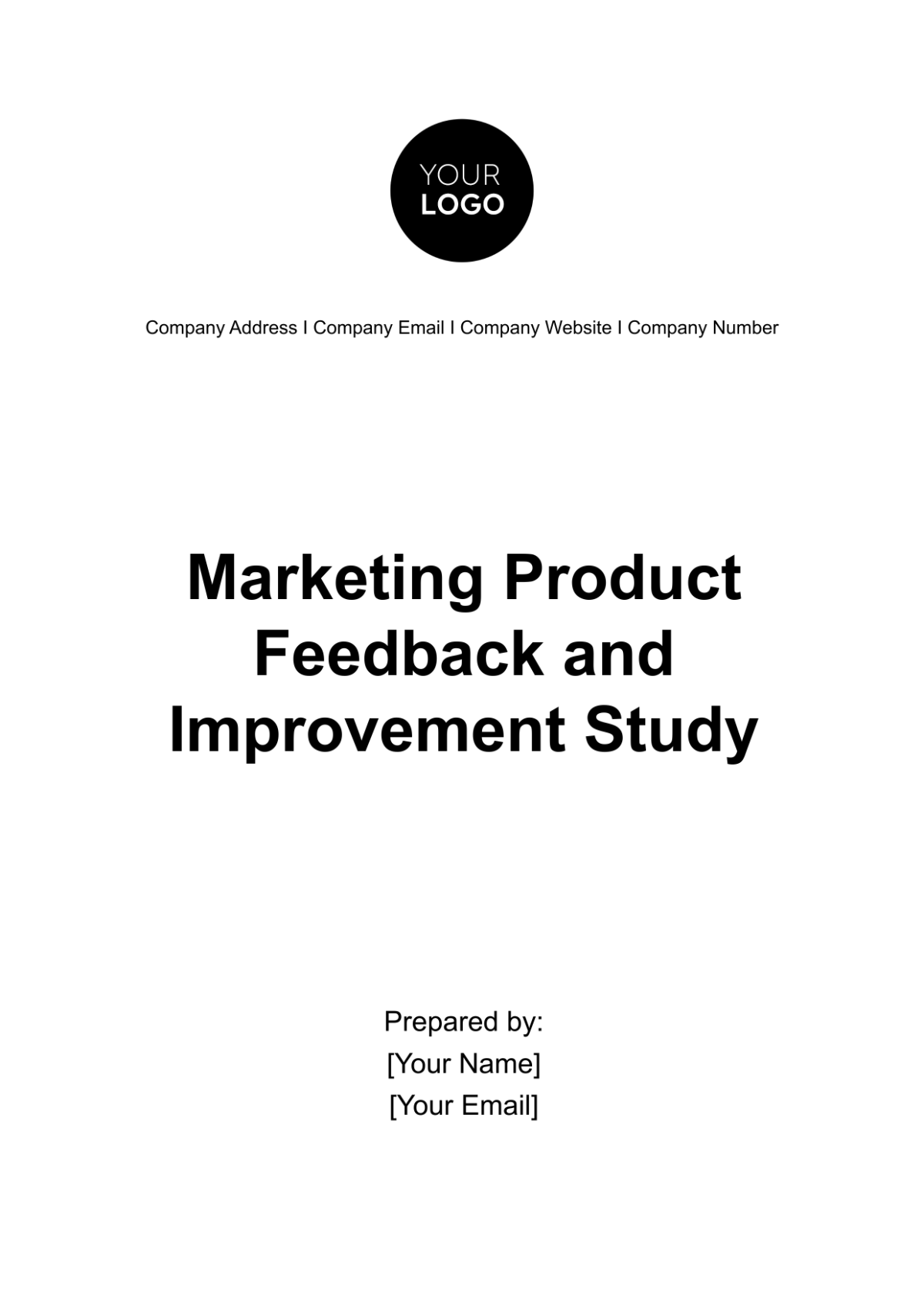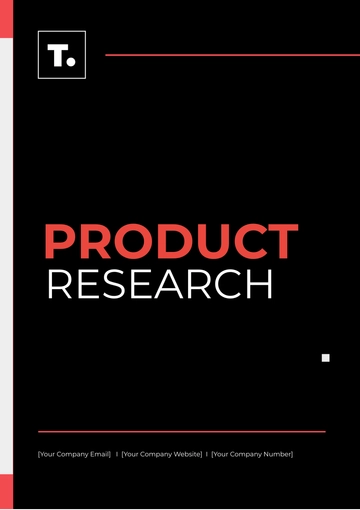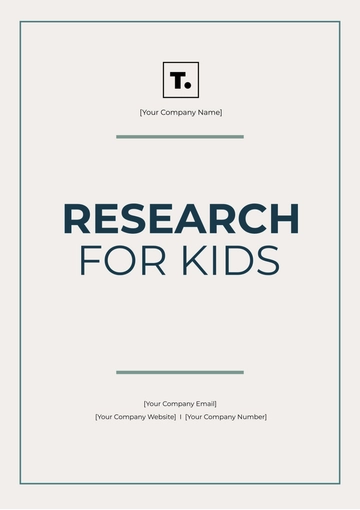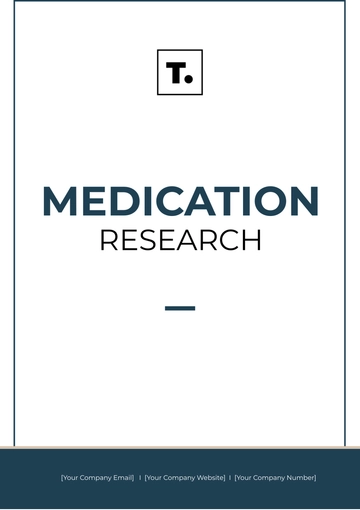Free Marketing Product Feedback and Improvement Study

I. Introduction
Welcome to the Marketing Product Feedback and Improvement Study, a comprehensive initiative led by [Your Company Name]. We deeply value your participation and insights as we continuously strive to refine and elevate our products and services. Your feedback holds immense importance in our journey towards excellence, and we are committed to turning your suggestions into actionable improvements.
In this study, we aim to gain a deeper understanding of your experiences and perceptions of our offerings. Your valuable input will shape the future of our products and guide our marketing strategies. Your contribution will not only benefit [Your Company Name] but also enhance your own experiences as our valued customer.
II. Methodology
The methodology employed in the Marketing Product Feedback and Improvement Study by [Your Company Name] was carefully designed to ensure the collection of meaningful and actionable insights. Our approach incorporated a mix of quantitative and qualitative research methods to provide a holistic view of our product's performance and customer satisfaction.
Data Collection
Surveys: We distributed online surveys to a representative sample of our customer base. These surveys were created with the input of marketing professionals and contained a series of structured questions aimed at quantifying customer satisfaction, identifying pain points, and gauging overall product performance.
In-depth Interviews: We conducted in-depth interviews with select customers to gain deeper insights into their experiences. These interviews allowed us to explore specific issues in detail, collect nuanced feedback, and understand the emotional aspect of their interactions with our product.
Focus Groups: We organized focus groups consisting of diverse participants. These sessions facilitated group discussions on product-related topics and encouraged participants to share their thoughts, ideas, and concerns openly.
Data Analysis
Our data analysis involved both quantitative and qualitative techniques. Quantitative data from surveys were subjected to statistical analysis to identify trends, correlations, and satisfaction ratings. Qualitative data from interviews and focus groups were transcribed and analyzed thematically to uncover recurring themes and sentiments.
Ethical Considerations
[Your Company Name] adheres to ethical guidelines in data collection and analysis. Participant privacy and data security were maintained throughout the study.
Our rigorous methodology ensured that the results are reliable, representative, and actionable, allowing us to make informed decisions for product improvements.
III. Participant Demographics
Understanding the diverse makeup of our participant pool is pivotal in shaping our strategies. In this section, we present a comprehensive analysis of participant demographics, categorizing responses by age group and key categories such as gender, occupation, education level, and more.
Accompanying this demographic analysis, you will find a visually informative stacked bar graph that provides a clear representation of how different demographic factors intersect within each age group. This valuable insight empowers us to tailor our product enhancements and marketing efforts to better serve our varied customer base.
Participant Demographics by Age Group and Category
IV. Data Collection
The foundation of our Marketing Product Feedback and Improvement Study is the systematic and thorough collection of data. We employed a multifaceted approach to gather insights, ensuring that we capture a holistic view of our product's performance and customer satisfaction.
Surveys
We distributed well-crafted online surveys to a representative sample of our customer base. These surveys, designed with input from marketing professionals, consisted of structured questions aimed at quantifying customer satisfaction, identifying pain points, and assessing overall product performance.
In-depth Interviews
To gain deeper insights, we conducted one-on-one interviews with select customers. These interviews allowed us to explore specific issues in detail, collect nuanced feedback, and understand the emotional aspect of their interactions with our product.
Focus Groups
We organized focus groups with diverse participants. These sessions encouraged open discussions on product-related topics, enabling participants to share their thoughts, ideas, and concerns openly. This qualitative method provided rich insights into customer perspectives.
Data Analysis
Our analysis process encompassed both quantitative and qualitative techniques. Quantitative data from surveys underwent statistical analysis to identify trends, correlations, and satisfaction ratings. Qualitative data from interviews and focus groups were transcribed and analyzed thematically to uncover recurring themes and sentiments.
Ethical Considerations
[Your Company Name] is committed to ethical data collection and analysis. Participant privacy and data security were maintained throughout the study, ensuring that our research adhered to legal and ethical guidelines.
This rigorous data collection methodology allowed us to gather reliable and representative data, ensuring that our findings are accurate and actionable.
V. Data Analysis
Understanding the diverse makeup of our participant pool is pivotal in shaping our strategies. In this section, we present a comprehensive analysis of participant demographics, categorizing responses by age group.
The following pie chart provides a visual representation of the distribution of participants across different age groups. It allows for a quick and clear understanding of the proportion of participants in each age category, highlighting the diversity of our respondent base.
VI. Key Findings
Key Finding | Percentage |
High Satisfaction | 75% |
Age Groups | |
18-24 | 85% |
25-34 | 80% |
35-44 | 70% |
45-54 | 65% |
65+ | 55% |
Gender Neutrality | |
Male | 74% |
Female | 76% |
Other | 70% |
Occupation Impact | |
Employed | 78% |
Students | 72% |
Retired | 65% |
Others | 70% |
VII. Customer Satisfaction
In this section, we delve into the heart of customer satisfaction, a cornerstone of our Marketing Product Feedback and Improvement Study. The following bar graph paints a vivid picture of our customers' sentiments regarding their overall satisfaction with our product. It categorizes responses into distinct levels of satisfaction, offering a comprehensive view of how our product resonates with our valued user base.
VIII. Areas for Improvement
Identifying and addressing areas that require enhancement is fundamental to our mission of delivering a superior product and customer experience. In this section, we outline key findings and insights gained from our study, pinpointing specific aspects that warrant focused attention and improvement.
Performance Metrics
We analyzed performance metrics, such as page load times and response rates, which highlighted areas needing optimization.
User Experience
User feedback highlighted challenges in navigating our interface, emphasizing the need for an improved user experience.
Feature Enhancement
Customer suggestions and requests for additional features or improvements provide guidance for our development roadmap.
Customer Support
Response times and customer support efficiency emerged as areas where enhancements can lead to improved customer satisfaction.
IX. Competitor Analysis
To stay at the forefront of the market, it's essential to understand the competitive landscape thoroughly. In this section, we present a comprehensive analysis of our key competitors, their strengths, weaknesses, and notable strategies.
Competitor | Strengths | Weaknesses | Marketing Strategies |
1 |
|
|
|
2 |
|
|
|
3 |
|
|
|
X. Action Plan
In this pivotal section, we outline the concrete steps and strategies we will undertake based on the insights and findings from our Marketing Product Feedback and Improvement Study. Our aim is to translate this valuable data into actionable initiatives that will enhance our product, customer experience, and overall market position.
Action Plan Initiatives | Description | Timeline |
Performance Optimization | Address performance bottlenecks for 10% improvement. | Q1-Q2 2053 |
User Experience Enhancement | Redesign UI for intuitive navigation and seamless experience. | Q2-Q3 2053 |
Feature Development | Prioritize development of "Advanced Search" and "Mobile App." | Q3-Q4 2053 |
Customer Support Enhancement | Reduce response times by 15% through training and process improvement. | Q1-Q2 2054 |
- 100% Customizable, free editor
- Access 1 Million+ Templates, photo’s & graphics
- Download or share as a template
- Click and replace photos, graphics, text, backgrounds
- Resize, crop, AI write & more
- Access advanced editor
Introducing the Marketing Product Feedback and Improvement Study Template from Template.net! Enhance your product strategy with this customizable tool. Editable within our AI Editor Tool, it facilitates personalized feedback analysis. Seamlessly delve into consumer insights, crafting actionable improvement plans effortlessly. Empower your marketing efforts with this essential resource for refining product performance.





























